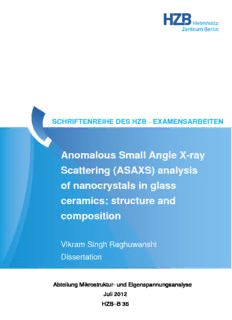
Anomalous Small Angle X-ray Scattering (ASAXS) PDF
Preview Anomalous Small Angle X-ray Scattering (ASAXS)
SCHRIFTENREIHE DES HZB · EXAMENSARBEITEN Anomalous Small Angle X-ray Scattering (ASAXS) analysis of nanocrystals in glass ceramics: structure and composition Vikram Singh Raghuwanshi Dissertation Abteilung Mikrostruktur- und Eigenspannungsanalyse Juli 2012 HZB–B 35 Berichte des Helmholtz-Zentrums Berlin (HZB-Berichte) Das Helmholtz-Zentrum Berlin für Materialien und Energie gibt eine Serie von Berichten über Forschungs- und Entwicklungsergebnisse oder andere Aktivitäten des Zentrums heraus. Diese Berichte sind auf den Seiten des Zentrums elektronisch erhältlich. Alle Rechte an den Berichten liegen beim Zentrum außer das einfache Nutzungsrecht, das ein Bezieher mit dem Herunterladen erhält. Reports of the Helmholtz Centre Berlin (HZB-Berichte) The Helmholtz Centre Berlin for Materials and Energy publishes a series of reports on its research and development or other activities. The reports may be retrieved from the web pages of HZB and used solely for scientific, non-commercial purposes of the downloader. All other rights stay with HZB. ISSN 1868-5781 doi: http://dx.doi.org/10.5442/d0029 Helmholtz-Zentrum Berlin für Materialien und Energie · Hahn-Meitner-Platz 1 · D-14109 Berlin · Telefon +49 30 8062 0 · Telefax +49 30 8062 42181 · www.helmholtz-berlin.de Anomalous Small Angle X-ray Scattering (ASAXS) analysis of nanocrystals in glass ceramics: structure and composition vorgelegt von Vikram Singh Raghuwanshi aus Bhopal (Indien) der Fakultät III-Prozesswissenschaften der Technischen Universität Berlin zur Erlangung des akademischen Grades Doktor der Naturwissenschaften -Dr. rer. nat.- genehmigte Dissertation Promotionsausschuss: Vorsitzender: Prof. Dr. Walter Reimers Gutachter: Prof. Dr. John Banhart Gutachter: Prof. Dr. Klaus Rademann Gutachter: Prof. Dr. Christian Rüssel Tag der wissenschaftlichen Aussprache: 31.5.2012 Dedicated to: All the relations to whom I am connected ABSTRACT The aim of the present work is a quantitative analysis of nanocrystallites with respect to their structures and compositions. This analysis will be done for all involved phases (crystalline and amorphous) of two different nanoglass ceramics by using anomalous small angle X-ray scattering (ASAXS) as a main method. Properties of glass ceramics depend on size, size distribution, volume fraction and on the composition of the formed nanocrystals and the remaining glass matrix. Glass ceramics that contain nano-scale magnetic crystals showing special magnetic properties have many future applications. ASAXS investigations on these glass ceramics containing magnetic nanoparticles show the formation of a Mn Fe O crystalline phase x 3-x 4 during heat treatment. The nanoparticles are surrounded by a thin layer enriched with SiO . 2 Furthermore, the ratio of Fe and Mn atoms in the nanosized crystals is determined by ASAXS. The investigations show that the crystal composition changes from magnetite (Fe O ) towards the Jacobsite phase (MnFe O ) with increasing annealing time. SANS 3 4 2 4 investigations with polarized neutrons prove the existence of spherical core-shell like structures. SANS also demonstrates that the nanoparticles are magnetic and the surface near region is magnetically disturbed. A so called magnetic dead layer is formed. Such a nanocrystal is surrounded by a nonmagnetic shell region. Barium fluoride (BaF ) based nanocrystals doped with rare earth elements in silicate 2 glasses are potential materials for various photonic applications such as optical amplifiers or fiber lasers. Energy filtering TEM studies imply that in glass ceramic containing nanosized crystals of BaF a shell like region surrounding the crystals exists that is enriched with SiO . 2 2 ASAXS investigations on these samples confirm the formation of such layers enriched with SiO . Furthermore, these investigations provide quantitative information about the 2 composition of the layer and the residual glass matrix and their temperature dependent composition changes. In the present work, it will be shown how ASAXS combined with other investigation methods is able to provide quantitative information on structure and compositions of nanoparticles in multiphase systems. The two investigated glass ceramics belong to this group of multiphase systems. I ZUSAMMENFASSUNG Das Ziel der vorliegenden Arbeit ist eine quantitative Analyse von Nanokristallen in Bezug auf deren Struktur und Zusammensetzung. Diese Analyse wird von allen beteiligten Phasen (kristallin und amorph) von zwei verschiedenen Nano-Glaskeramiken mit Hilfe der anomalen Röntgenkleinwinkelstreuung (ASAXS) als wichtigste Methode durchgeführt. Die Eigenschaften der Glaskeramiken sind von der Größe, der Größenverteilung, der Volumenverteilung und der Zusammensetzung der gebildeten Nanokristalle sowie der restlichen Glasmatrix abhängig. Glaskeramiken, die magnetische Kristalle im Nanometerbereich enthalten, und damit spezielle magnetische Eigenschaften haben, versprechen viele zukünftige Anwendungen. Die ASAXS-Untersuchungen dieser Glaskeramiken mit magnetischen Nanopartikeln weisen die Bildung einer kristallinen Phase (Mn Fe O ) bei der Wärmebehandlung nach. Diese x 3-X 4 Nanopartikel sind durch eine dünne Schicht die mit SiO angereichert ist umgeben. Ferner 2 wird das Verhältnis von Fe- zu Mn-Atomen in den nanometergroßen Kristallen durch ASAXS bestimmt. Die Untersuchungen zeigen, dass sich die Kristallstruktur ändert und die Zusammensetzung sich von Magnetit (Fe O ) in Richtung der Jacobsite Phase (MnFe O ) mit 3 4 2 4 zunehmender Wärmebehandlungszeit ändert. SANS Untersuchungen mit polarisierten Neutronen weisen nach, dass sich eine Kern-Schale-Struktur gebildet hat, Weiterhin weist SANS nach, dass die Nanopartikel magnetisch sind sowie deren oberflächennahe Schicht magnetisch gestört ist, d.h. eine sogenannte dünne magnetische Totschicht wird ausgebildet. Umgeben ist solch ein Nanokristall von einer nichtmagnetischen Hüllenregion. Nanokristalle, wie BaF in Silikat-Gläsern in Anwesenheit von seltenen Erden, sind 2 potenzielle Materialien für verschiedene photonische Anwendungen wie optische Verstärker oder Faserlaser. TEM-Studien mit Energie-Filterung implizieren, dass in einer Glaskeramik, die nanometergroße Kristalle aus BaF enthält, sich eine Region rund um die Kristalle bildet, 2 die mit SiO angereichert ist. ASAXS Untersuchungen an diesen Proben bestätigen die 2 Bildung einer solchen Schicht, die mit SiO angereichert ist. Darüber hinaus bieten diese 2 Untersuchungen quantitative Informationen über die Zusammensetzung der Hüllen-Schicht und der Restglasmatrix sowie deren temperaturabhängigen Zusammensetzungsänderungen. In dieser Arbeit wird gezeigt wie ASAXS in Kombination mit anderen hier verwendeten Untersuchungsmethoden in der Lage ist, quantitative Informationen über Struktur und Zusammensetzung von Nanopartikeln in mehrphasigen Systemen zu liefern. Die beiden hier untersuchten Glaskeramiken gehören zu diesen mehrphasigen Systemen. III
Description: